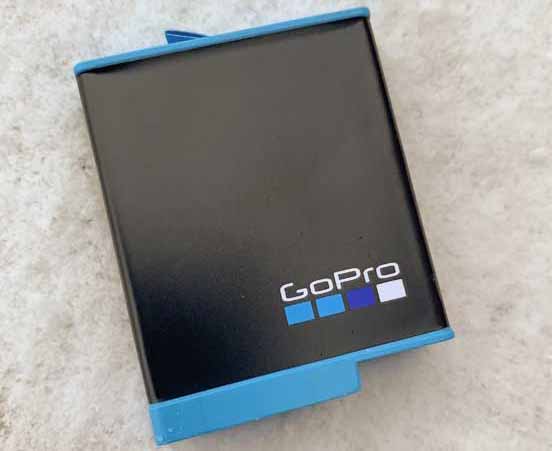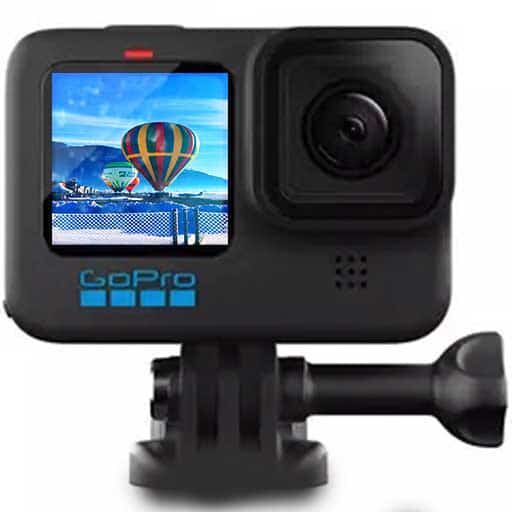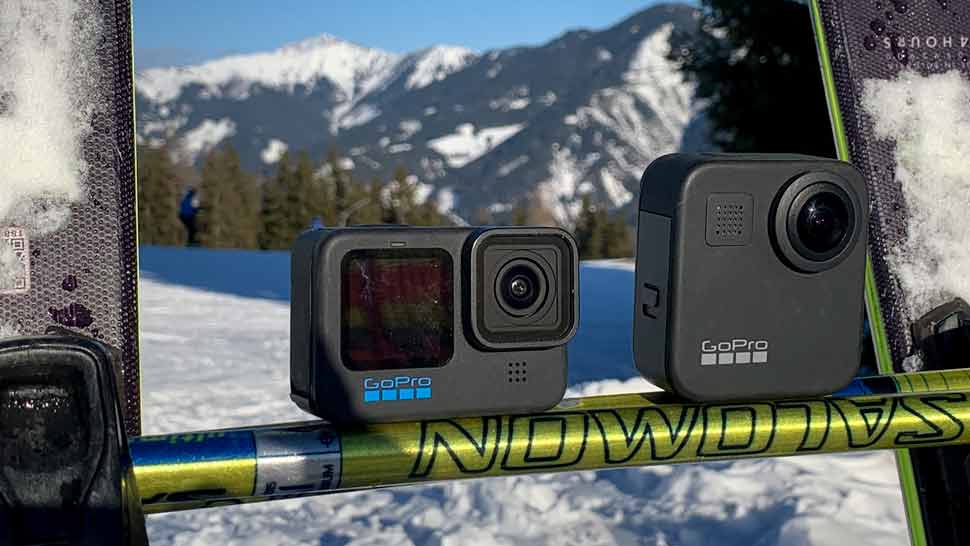Best GoPro For Skiing – Hero 10 Black vs GoPro Max 360 Camera
Having spent a whole ski season with both the GoPro Hero 10 Black and GoPro Max 360 cameras. I felt it would be worthwhile sharing my experiences with both cameras to see which is the best GoPro for skiing.
The focus of this article is looking at the features of both cameras in regards to snow skiing. I will in turn go through each of the most used settings and modes I use and compare each camera in how they perform for each.
Note: This article will be updated this coming ski season, 2022 / 2023. I will be taking the new GoPro Hero 11 to Austria for the ski season all being well. I will be testing the new 8:7 aspect ratio and the 10-bit color profile along with Stabilization tests and a whole load of other GoPro settings for skiers. Stay tuned!
GoPro Hero 10 Overview

The Hero 10 Black is the latest camera from GoPro. If tradition holds, expect to see the new Hero 11 Black released around the end of September 2022. This has been GoPro’s launch date for a number of years now for their new camera releases.
As with all action sports image stabilization is one of the most important features for an action camera. Sporting the new G2 processor, the Hero 10 records 4K video up to 120 frames per second and boasts HyperSmooth 4.0 stabilization.
What this means for the skier is high resolution video and buttery smooth stable video while tackling the most demanding terrain. Read my article on skiing settings for the Hero 10 for more information.
Both cameras have voice command which works very well, especially when the camera is mounted on a ski helmet, along with a large audiable beep alerting you to the shutter being active. These two features are so useful to skiers who use GoPro cameras from my personal experience.
Specification
- Video: 5.3K at 60 fps, 4K at 120 fps, 2.7K at 240 fps
- Video stills up to 19.6 megapixels
- 23MP stills photos
- HyperSmooth 4.0 video stabilization
- 45° horizon leveling in 4K60, 2.7K120 and 1080p120 video
GoPro Max 360 Overview

The GoPro Max 360 is almost an entirely different camera compared to the Hero 10 Black. For a start the Max 360 as the name suggests, captures both video and photos with a 360-degree field of view.

Two lenses, one at both front and rear of the camera capture scenes in 360 degrees. The internal camera software stitches together the two lens images to create a single video or photo file.
Not only does the Max record in 360-degrees. There is the option to use a single lens and record “flat” images in what is known as Hero Mode.
Having a camera that records in 360 allows the skier to reframe their footage later in post using the GoPro Quik app. This opens up a whole tonne of possibilities we’ll look at further in this article.
Max 360 Specification
- 360 Video: 5.6K at 30 fps
- HERO Mode: 1440p at 60 fps / 1080p at 60 fps
- Photo Resolution 16.6 MP
- Hypersmooth 2.0 video Stabilization
- GPS Metadata only available in Hero Mode
Key GoPro Features For Snow Skiing

As with most action sports and activities. When it comes to filming with an action camera each activity requires different camera techniques.
I’ll now share with you all the key aspects for both cameras I discovered worked great while on the slopes.
Features
In terms of design, the cameras are quite different in appearance. The Max has a single large LCD screen at the rear of the camera body.
LCD Screen
The Hero 10 has a dual screen set up. A larger screen at the rear and a small screen at the front.
You don’t spend a whole lot of time looking at the LCD screen when skiing. Apart from setting up a photo or video.
Unless you’re vlogging. In which case the Max has the edge as you can flip the camera lens so the LCD screen is facing you. The 6 microphones built into the Max are better suited to picking up spoken word too.
Folding Fingers
As with all the later model GoPro cameras, both have folding fingers at the base of the camera body. This makes it relatively quick to mount the camera to a ski helmet for example.
I’d like to see some type of magnetic mounting system similar the DJI Action 2 for future GoPro cameras as it would speed up the camera mounting process greatly.
Frame Rates
One of the first specifications people look at when comparing cameras is frame rates. The Hero 10 wins hands down in this area compared to the Max 360.
If you want to record super slow motion action footage, the Hero 10 will record at 240 frames per second. The Max only manages a mere 60 fps in both Hero Mode and 360 Mode.
Image Stabilization
The progress in image stabilization has been incredible over the last few years. I remember being super impressed with the Hero 7 Black when I first took it on the slopes back in the day.
Sporting the new G2 processor, the Hero 10 Black has the greater ability to stabilise video footage compared to the Max 360 in Hero Mode.
However the Max does have a trick up its sleeve. Remember the Max records video in 360 Mode. This is where buy using the GoPro Quik app you can smooth out a lot of camera shake with the gyroscopic setting switched ON.

360 Mode
Of course the GoPro Max is the only camera in this comparison that’ll shoot in 360. This makes up for the lack of frame rates available compared to the Hero 10.
There are a whole tonne of ways to use a 360 degree camera. Mostly with a selfie stick. I’m sure you have seen footage of the camera seemingly floating while tracking a skier down a mountain.
This is all done by using the invisible selfie stick technique which is a whole lot of fun. Also mounting the Max to the front of a ski helmet gives the skier the ability to reframe 360 footage in post production.
Reframing 360 Video & Photos
For those who are not familiar with the term “reframing”. What this means is the ability to select any frame using key frames in software such as the Quik app.
With 360 degree footage it’s possible to choose the aspect ratio after the scene has been filmed. Let’s say perhaps you’d like to share a video on Instagram in 9:16 aspect or YouTube in 16:9 ratio.
Being able to reframe 360 footage, both video and photos opens up a whole world of creative possibilities, especially when it comes to skiing content.
Photo Modes
In terms of features and actual picture quality the Hero 10 is the best option here when it comes to flat images, or non-360 photos.
Panoramic Photos
Having 2 lenses the Max does perform better of the two cameras when it comes to panoramic photos. setting the shutter on timer is essential though to ensure you capture sharp photo image.
The Max has a dedicated mode called PowerPano to take a wide angle photo with a 270 degrees field of view.
Burst Mode
Burst Mode is available on the Hero 10 and I’d like to see this mode introduced to the upcoming latest version of the Max due for launch later this year.
Getting the perfect photo while popping a jump is never easy. With Burst Mode you can set the camera to take a burst of multiple photos in quick succession over a short period of time.
Hyperlapse
Both cameras shoot hyperlapse footage. The main difference being the Max 360 records using both camera lenses. This allows you to reframe hyperlapse footage.
A great example is sitting on a chair lift using an invisible selfie stick and recording a hyperlapse as you head up the mountain.
Battery Life

Lithium batteries don’t like the cold as we all know. The standard battery that comes with the Hero 10 is an improvement on older GoPro batteries.
I’d suggest taking a look at the Enduro battery if you plan on taking lots of footage in the mountains in the winter months.
There isn’t an Enduro battery option for the Max. However, the good news is the standard battery is very good indeed.
Even when mounting the Max onto a ski helmet and letting the camera record constantly, you’ll capture well over 20 minutes of footage depending on the air temperature and wind chill.
Taking at least one spare battery with you is never a bad idea though. And always try to keep your batteries warm while on the mountain.
Final Thoughts
Well there you have it. My personal insight into using both cameras side by side over the course of a 3 month ski season.
I’m going to go into more detail on the settings for each individual camera and how I get the best results for recording skiing footage in further articles on this website, stay tuned!
Finally, I hear you ask which is the best? Well, in a perfect world I’d say take both with you onto the slopes if you can afford to.
The Hero 10 has far more frame rates to play with, plus the better stabilization and horizon levelling.
If I had to choose between the two cameras, then I’d have to go with the GoPro Max 360. The reason is, it’s just a whole lot of fun recording video and taking photos in 360 and sharing them with friends, family and the whole world for that matter.
Whichever camera you choose, just go out there and have a lot of fun. Stay safe on the slopes and I may just see you out there next season.
Alternative Camera Options
If you’re still unsure whether one of the latest GoPro cameras fits your needs. It’s worth taking a look at the DJI Action 2 or the Insta360 One RS.
I will be writing a full review of the DJI Action 2 in regards to how it performs when skiing very soon.




